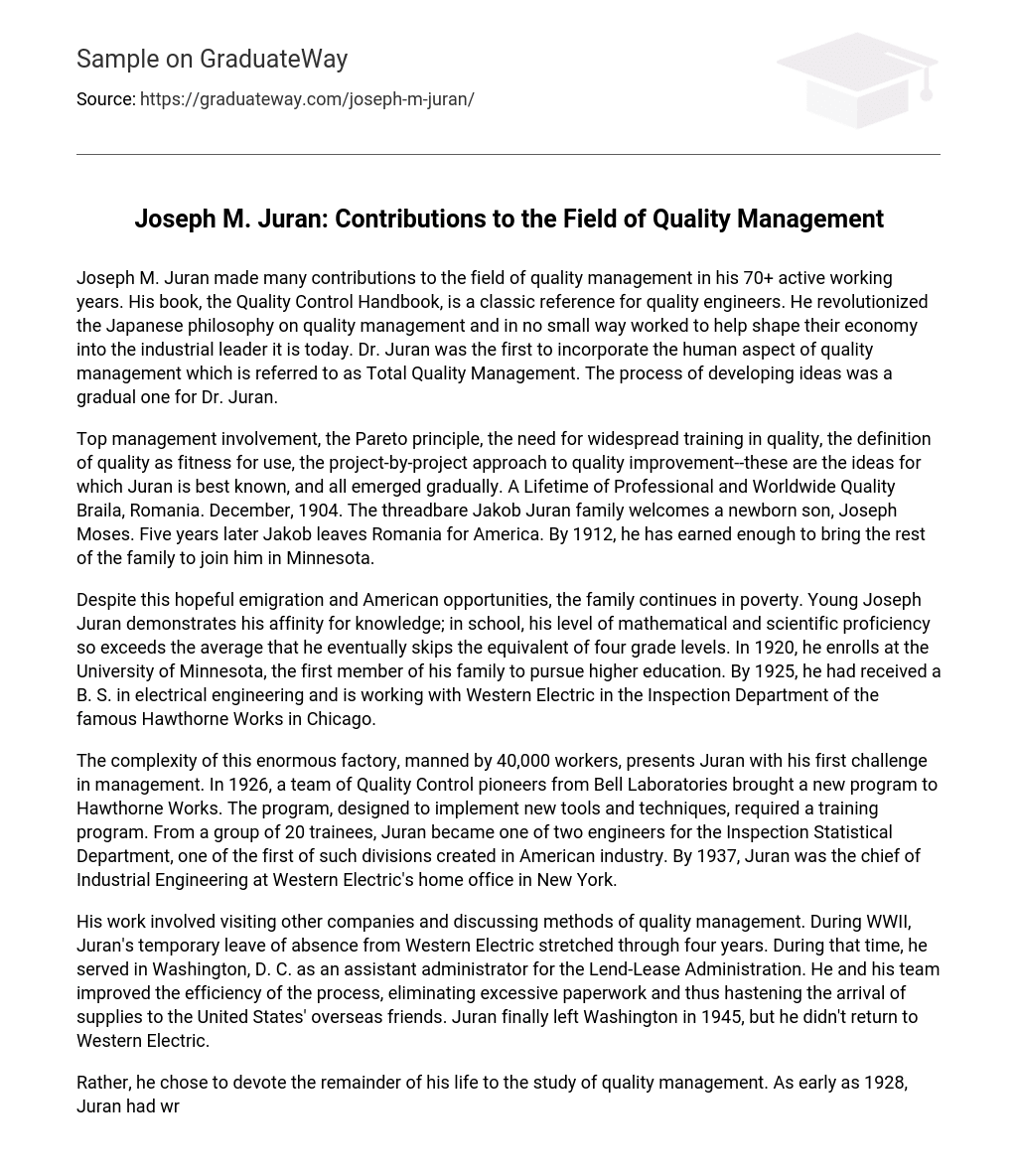Joseph M. Juran made many contributions to the field of quality management in his 70+ active working years. His book, the Quality Control Handbook, is a classic reference for quality engineers. He revolutionized the Japanese philosophy on quality management and in no small way worked to help shape their economy into the industrial leader it is today. Dr. Juran was the first to incorporate the human aspect of quality management which is referred to as Total Quality Management. The process of developing ideas was a gradual one for Dr. Juran.
Top management involvement, the Pareto principle, the need for widespread training in quality, the definition of quality as fitness for use, the project-by-project approach to quality improvement–these are the ideas for which Juran is best known, and all emerged gradually. A Lifetime of Professional and Worldwide Quality Braila, Romania. December, 1904. The threadbare Jakob Juran family welcomes a newborn son, Joseph Moses. Five years later Jakob leaves Romania for America. By 1912, he has earned enough to bring the rest of the family to join him in Minnesota.
Despite this hopeful emigration and American opportunities, the family continues in poverty. Young Joseph Juran demonstrates his affinity for knowledge; in school, his level of mathematical and scientific proficiency so exceeds the average that he eventually skips the equivalent of four grade levels. In 1920, he enrolls at the University of Minnesota, the first member of his family to pursue higher education. By 1925, he had received a B. S. in electrical engineering and is working with Western Electric in the Inspection Department of the famous Hawthorne Works in Chicago.
The complexity of this enormous factory, manned by 40,000 workers, presents Juran with his first challenge in management. In 1926, a team of Quality Control pioneers from Bell Laboratories brought a new program to Hawthorne Works. The program, designed to implement new tools and techniques, required a training program. From a group of 20 trainees, Juran became one of two engineers for the Inspection Statistical Department, one of the first of such divisions created in American industry. By 1937, Juran was the chief of Industrial Engineering at Western Electric’s home office in New York.
His work involved visiting other companies and discussing methods of quality management. During WWII, Juran’s temporary leave of absence from Western Electric stretched through four years. During that time, he served in Washington, D. C. as an assistant administrator for the Lend-Lease Administration. He and his team improved the efficiency of the process, eliminating excessive paperwork and thus hastening the arrival of supplies to the United States’ overseas friends. Juran finally left Washington in 1945, but he didn’t return to Western Electric.
Rather, he chose to devote the remainder of his life to the study of quality management. As early as 1928, Juran had written a pamphlet entitled “Statistical Methods Applied to Manufacturing Problems. ” By the end of the war, he was a well-known and highly-regarded statistician and industrial engineering theorist. After he left Western Electric, Juran became Chairman of the Department of Administrative Engineering at New York University, where he taught for many years. He also created a thriving consulting practice, and wrote books and delivered lectures for American Management Association.
It was his time with NYU and the AMA which allowed for the development of his management philosophies which are now embedded in the foundation of American and Japanese management. His classic book, the Quality Control Handbook, first released in 1951, is still the standard reference work for quality managers. The following table outlines the major points of Dr. Juran’s quality management ideas: Quality Trilogy: Quality Planning Identify who are the customers. Determine the needs of those customers. Translate those needs into our language.
Develop a product that can respond to those needs. Optimise the product features so as to meet our needs and customer needs. Quality Improvement Develop a process which is able to produce the product. Optimise the process. Quality Control Prove that the process can produce the product under operating conditions with minimal inspection. Transfer the process to Operations. An Honored Theorist The Union of Japanese Scientists and Engineers invited Dr. Juran to Japan, to teach them the principles of quality management as they rebuilt their economy. Along with W. Edwards Deming, his more colorful and perhaps better-known American colleague, Juran received Second Order of the Sacred Treasure award from Emperor Hirohito of Japan. Dr. Juran published his lectures from Japan in his book Managerial Breakthrough in 1964. In 1979, Juran founded The Juran Institute to better facilitate broader exposure of his ideas. The Juran Institute is today one of the leading quality management consultancies in the world, and it produces books, workbooks, videos and other materials to support the wide use of Dr. Juran’s methods.
The institute and the consulting practice continues to thrive today. Dr. Juran worked to promote quality management into his 90’s, and only recently retired from his semi-public life. One can obtain the papers, lectures, and tapes of Dr. Juran from The Juran Institute or other quality management educational providers. The Juran Foundation, which he founded, continues his work, exploring the social and industrial implications of quality improvement while making his and others’ valuable contributions more accessible.





